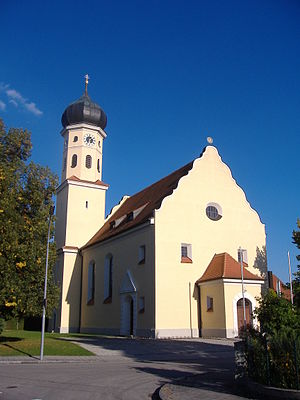To the Immaculate Conception of Mary (Hundszell)
The branch church of the Immaculate Conception of Mary is a Roman Catholic sacred building in Hundszell , a district and sub-district of the independent city of Ingolstadt . The church was from 1912 to 1914 according to plans by Anton Bachmann in baroque- home style built.
Building history
Hundszell, the oldest of the so-called “Audörfer” in the south of Ingolstadt, was the presumed location of a mission church in the early Middle Ages . Ostermaier assumes that at least around 1240 there was a church that belonged to the castle of the extinct family of the Hundsbergers and was consecrated to Saint Rupert , who is still particularly venerated in the area today. However, so far no remains have been found either from the castle or the church.
Since 1407/08 Hundszell, which was now part of the city, was pastorally assigned to the Ingolstadt cathedral parish , while the burials took place in the cemetery of the Salvator Church in neighboring Unsernherrn . Possibly as early as 1893, but no later than 1894, a Hundszell church building association was founded with the aim of building a branch church in Hundszell . In the same year, the Massenhausers transferred the property with corridor no. 1477 and a size of 0.968 hectares belonging to the Unsernherrn Church Foundation, so that in due course it can be assigned to a Hundszell branch church foundation as a building site for a new church. However, the start of construction was delayed for several years because the financing of the church building was not secured. Finally, on March 17, 1912, the Vicar General and Cathedral Dean, Prelate Dr. Georg Triller, Eichstätt, the foundation stone for the church was laid. The construction work according to plans by the Munich architect Anton Bachmann was carried out by Magnus Wieser from Kelheim , the construction management was subject to district master builder Knab. The First World War began on August 1, 1914. Of course, this event also had consequences for the building of the church in Hundszell. Financial problems and delivery difficulties of the craftsmen meant that the interior of the church could only be partially completed. In a letter dated September 30, 1914, Pastor Schröder asked the Episcopal Ordinariate for authorization to benedict the new church. Because of the war, the celebration should be kept as simple as possible and, at the request of the branch community, take place on church fair Monday. On October 1, 1914, the episcopal ordinariate granted the requested permission and on October 19, 1914, the consecration Monday of 1914, the new church was designated by Dean Schröder. The inauguration itself has to be postponed until later due to the war and the difficult time that followed. It was not until 20 years later, on September 30, 1934, that St. Mary's Church was consecrated by the recently appointed Eichstatt Bishop Konrad Graf von Preysing . From 1953 Hundszell was looked after by the newly founded parish Herz-Jesu in Haunwöhr , but officially remained part of the parish Unsernherrn. It was not until August 28, 1967 that the Church Foundation “Maria Immaculate Conception” officially became part of the parish Herz Jesu. In the years 1949, 1965 and 2002 the Marienkirche was restored outside, in 1962, 1980 to 1983 and 2003 inside .
architecture
The branch church is surrounded by a large green area in the center of Hundszell at the intersection of the former main street (today Probststraße, named after the initiator of the church building Alois Probst) and Kirchstraße. When designing the exterior, Anton Bachmann took up typical elements of the Bavarian rural baroque architecture , which were combined to create a picturesque effect. The simple nave is accentuated by decorative tail gables and a small west porch with a hipped gable roof . With the exception of the north portal, which, contrary to Bachmann's plan, was only implemented in a simplified manner, the outer walls are almost completely unadorned. The sacristy in the south and the bell tower in the north adjoin the retracted choir with detached buttresses ; its two lower, square floors are crowned by a two-story octagon with an onion dome . The interior is illuminated through segmental arched window openings. While the nave closes off a flat wooden ceiling, the choir has a needle cap barrel .
Furnishing
Despite the restorations in the post-war period, the interior furnishings from the construction period have been almost completely preserved, so that the unified image of a rural church space in the spirit of the historicizing Heimatstil , mixed with elements of Art Nouveau , has been preserved to this day. The three altars from the construction period and the pulpit are kept in alienated baroque forms, as they were typical of the Munich church building of the time, for example in the works of the brothers Franz and Josef Rank . The paintings on the side altars were created by Albert Figel in 1934 . The organ from the Bittner company, Eichstätt , on the west gallery was not purchased until 1946, but the design of the prospectus is based on the design language of the original equipment.
photos
Individual evidence
- ↑ Huber, Alois: Baiovaren time. St. Ruperts Age Question, Salzburg: Pustet / Zaunrith 1874 (History of the introduction and spread of Christianity in Southeast Germany, Vol. 2), p. 496.
- ^ Franz Xaver Ostermaier: Our Lord . In: Collection sheet of the historical association in and for Ingolstadt . tape 18 , 1893, ISSN 1619-6074 , p. 53–54 ( digitized version [accessed December 21, 2012]).
literature
- Becker, Frank / Grimminger, Christina / Hemmeter, Karlheinz: City of Ingolstadt. Half volume 2, Munich: Karl M. Lipp, 2002 (Monuments in Bavaria, Vol. I.1), ISBN 3-87490-583-7 , pp. 552-53.
Web links
Coordinates: 48 ° 44 ' N , 11 ° 24' E


